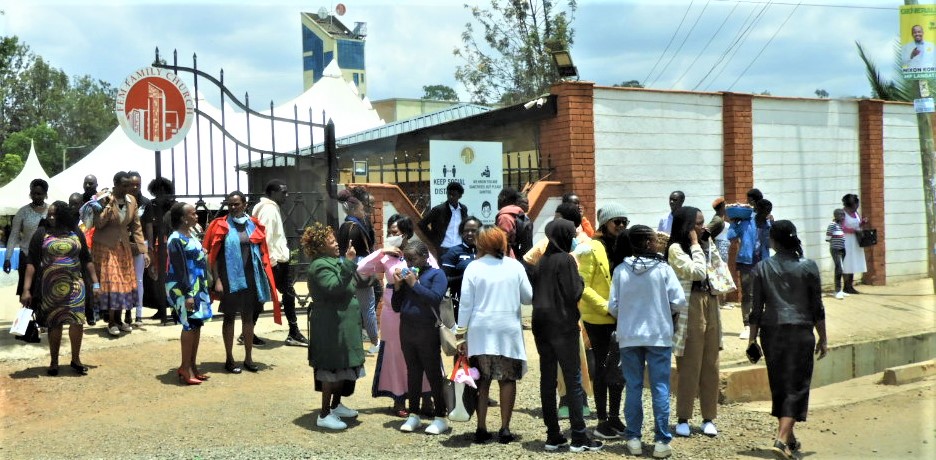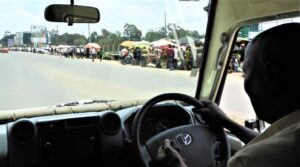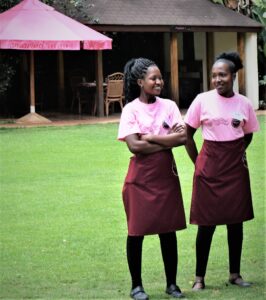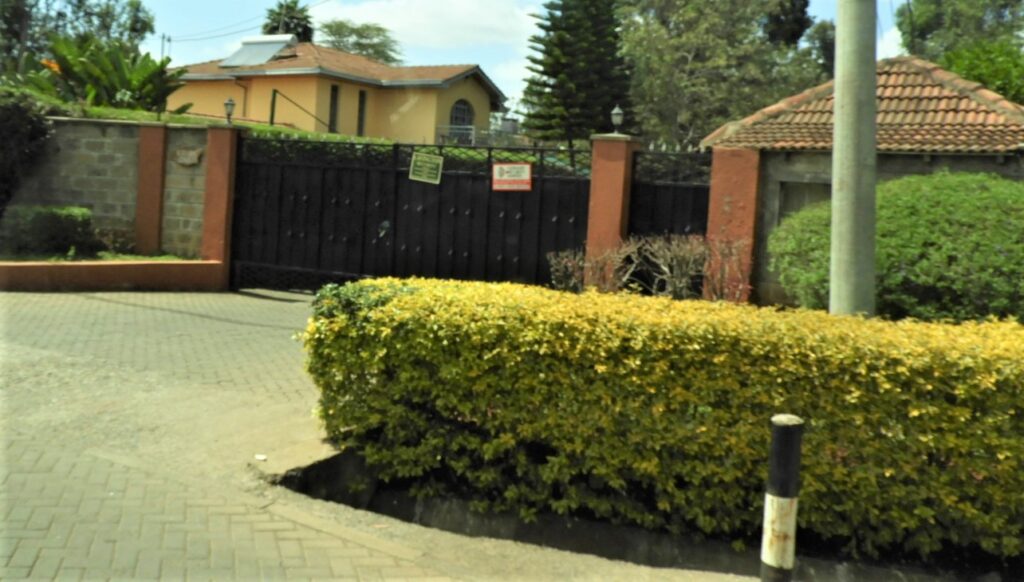» posted on Sunday, September 11th, 2022 by Linda Lou Burton
Karen Says
Linda Lou Burton posting from Nairobi, Kenya – “Remember me?” The Elephant Feeding was over now; the crowd filing out. Blethwell was on my left, Rick on my right, which is where  the voice came from. We paused, and there was Douglas! Douglas, who brought us from the airport Friday night. Rick stepped over, grabbed his hand. In all this crowd, here was a friend, remembering us. We stopped to chat, delighted to see a familiar face. Douglas had brought a group for the Elephant Feeding, he explained; he and Blethwell worked together, Globus representatives. We headed on, past the stables towards our vehicle; Daniel had pulled as close to the gate as possible. “Pole, pole,” he said as he helped me up my ladder step. “Are you ready for lunch?” “The Karen Blixen Museum is MY priority today,” I replied. “When do we go THERE?” “It’s open all afternoon,” Blethwell-the-scheduler answered. “First you get to relax over a nice lunch.”
the voice came from. We paused, and there was Douglas! Douglas, who brought us from the airport Friday night. Rick stepped over, grabbed his hand. In all this crowd, here was a friend, remembering us. We stopped to chat, delighted to see a familiar face. Douglas had brought a group for the Elephant Feeding, he explained; he and Blethwell worked together, Globus representatives. We headed on, past the stables towards our vehicle; Daniel had pulled as close to the gate as possible. “Pole, pole,” he said as he helped me up my ladder step. “Are you ready for lunch?” “The Karen Blixen Museum is MY priority today,” I replied. “When do we go THERE?” “It’s open all afternoon,” Blethwell-the-scheduler answered. “First you get to relax over a nice lunch.”
 Daniel made a left past Galleria Mall, easing onto Langata Road. It was Sunday-after-church time and crowds were spilling onto the streets. “Where are all the church people going to eat?” I inquired, thinking how fun it would be to go there, the way we did after-church lunch in the old days when the kids were little. “They’re going for Sunday chicken,” Daniel laughed,
Daniel made a left past Galleria Mall, easing onto Langata Road. It was Sunday-after-church time and crowds were spilling onto the streets. “Where are all the church people going to eat?” I inquired, thinking how fun it would be to go there, the way we did after-church lunch in the old days when the kids were little. “They’re going for Sunday chicken,” Daniel laughed,  pointing to the stands lining the streets. We passed Karen Hospital, crossed over Karen Road, made a right at Ngong Road. Then he slowed, turned left into a walled area, gated, guarded. It began to sink into my consciousness: we left our hotel through a guarded gate; we entered the Giraffe Centre and the Elephant Orphanage through guarded gates, and now, were we to have our Sunday lunch in a guarded area? Apparently so.
pointing to the stands lining the streets. We passed Karen Hospital, crossed over Karen Road, made a right at Ngong Road. Then he slowed, turned left into a walled area, gated, guarded. It began to sink into my consciousness: we left our hotel through a guarded gate; we entered the Giraffe Centre and the Elephant Orphanage through guarded gates, and now, were we to have our Sunday lunch in a guarded area? Apparently so.


 Tamarind Brasserie was a secluded, palm-surrounded haven of privacy, with individual covered patios around the perimeter of the grounds. Staff in pink uniforms sang greetings as we entered; I was escorted to my chair. “I’ll bring your food,” a beautiful young server said to me, “just tell me what you’d like.” Rick headed for the buffet with her; soon she returned with a perfectly arrayed plate of vegetables and rice for me; just what I’d requested. I thanked her, and commented on the peacefulness of the area. She smiled. “My name is Amani,” she said. “It means ‘peace’ in Swahili.”
Tamarind Brasserie was a secluded, palm-surrounded haven of privacy, with individual covered patios around the perimeter of the grounds. Staff in pink uniforms sang greetings as we entered; I was escorted to my chair. “I’ll bring your food,” a beautiful young server said to me, “just tell me what you’d like.” Rick headed for the buffet with her; soon she returned with a perfectly arrayed plate of vegetables and rice for me; just what I’d requested. I thanked her, and commented on the peacefulness of the area. She smiled. “My name is Amani,” she said. “It means ‘peace’ in Swahili.”
During the course of our lunch, as Amani continued to lavish attention on me, we exchanged details of our lives. “I share an apartment with my sister,” she said in answer to my question. “Whoever gets home first in the evening cooks for the other. We work long hours and have long drives so don’t have much spare time.” She asked about my life in the states; I drew an air-map of the US, pointing to my spot in the southern part of the country. By the time we got to dessert, Amani told me she planned to leave Kenya, explaining there were no jobs where she could use her education. “Where will you go?” I asked. “One of three places – Canada, Australia, or Germany,” she answered. “Pick Australia!” I laughed. “I’ve never met an Aussie I didn’t like, and Canada can get COLD in the winter.”
Blethwell appeared, checking to see if we were done; leading us across the grassy lawn, through the palm trees and flowers to the drive where Daniel waited with our vehicle. “Where did YOU guys eat lunch?” I inquired as we exited the gate. “A Sunday chicken place,” Daniel laughed. When we turned down Karen Road, I saw a sign advertising the Karen Blixen Museum ahead. We were in the Karen suburb, the white enclave of Nairobi.
I remembered a line from Karen Blixen’s Out of Africa book, written years after she left. Her 6,000-acre coffee plantation was a highlands area about ten miles from the 1913 town of Nairobi. Her dream for the natives – the Kikuyu and the Maasai that were such a part of her life – didn’t work out the way she’d hoped. Her plantation was bought by a company that dug up the coffee trees and divided the land into 20-acre plots. Her grief expressed in writing: “now the lands where my natives lived and worked are paved with tennis courts.”
“That’s MY house,” Daniel joked, pointing to a rooftop visible behind a gated stone wall. As we continued down the road, I noted lean-tos on the outside of these barbed-wire topped mansion walls. I am puzzled now, really paying attention to my surroundings. “Karen” describes itself today as “a center for many upscale restaurants and hotels in the city, offering cuisines from around the world. It is a vibrant residential suburb characterized by big mansions, many trees, tranquil atmosphere, and plush gardens. 
Depends, I guess, which side of the wall you’re on.
Next Stop: Karen Blixen Museum
